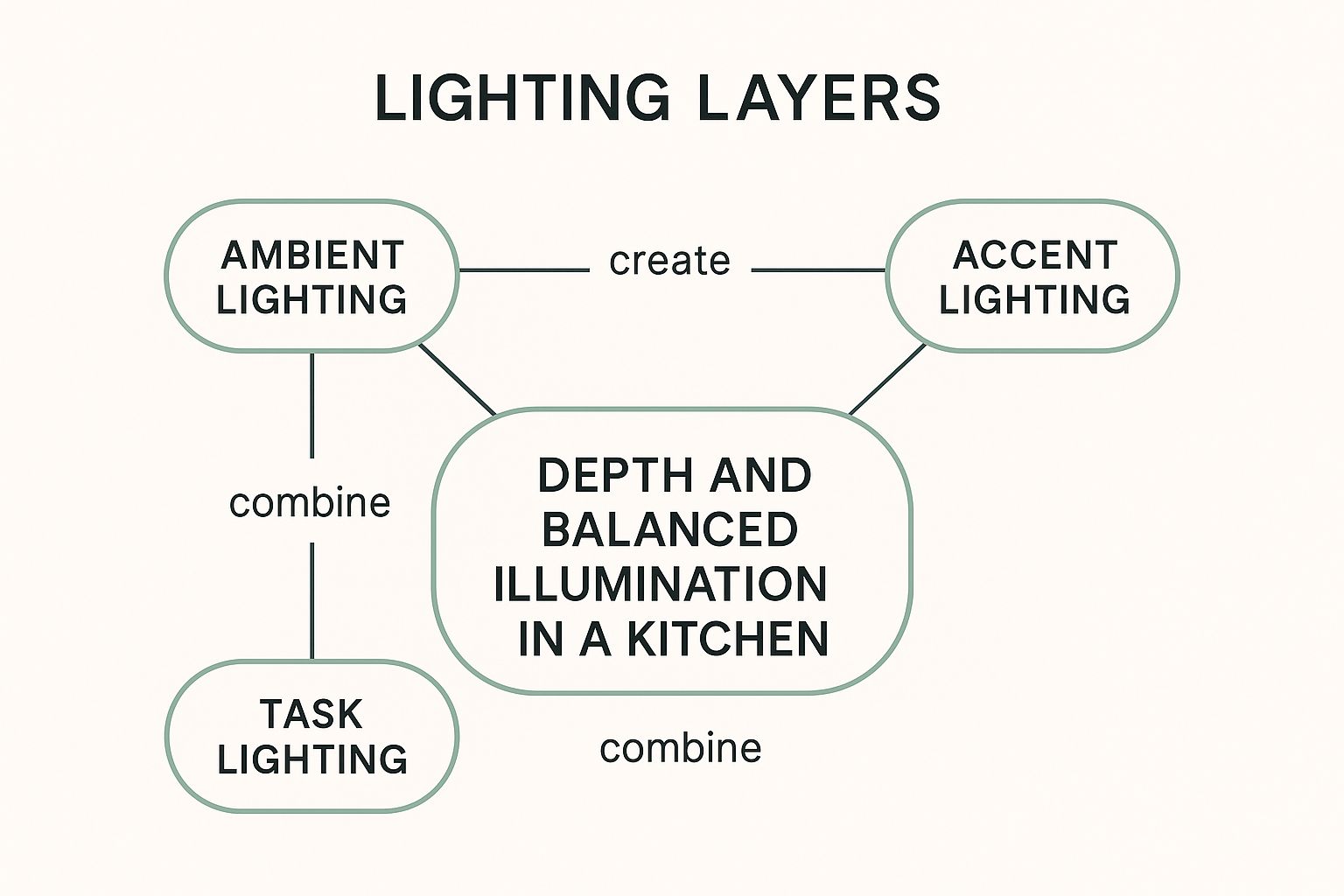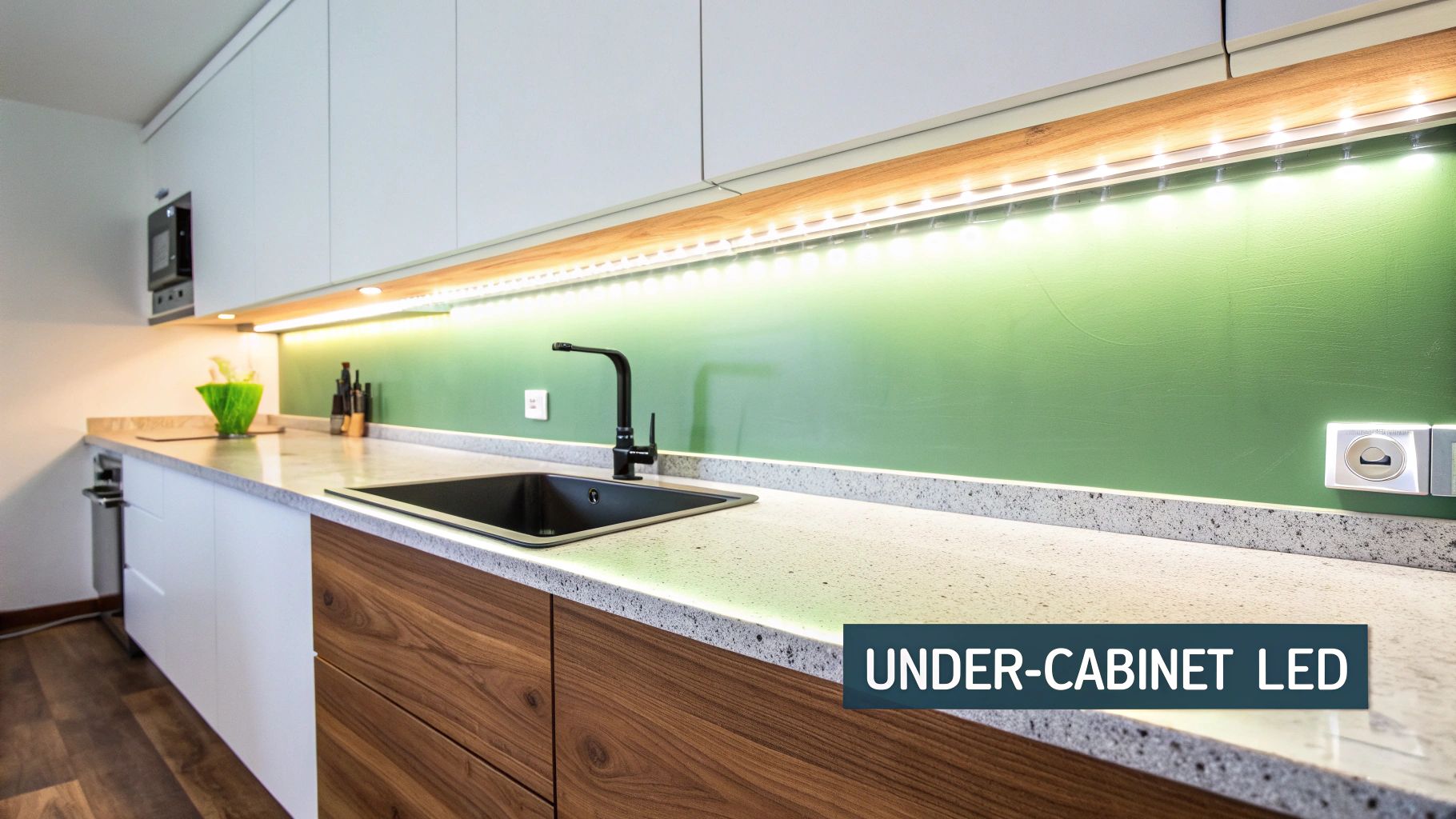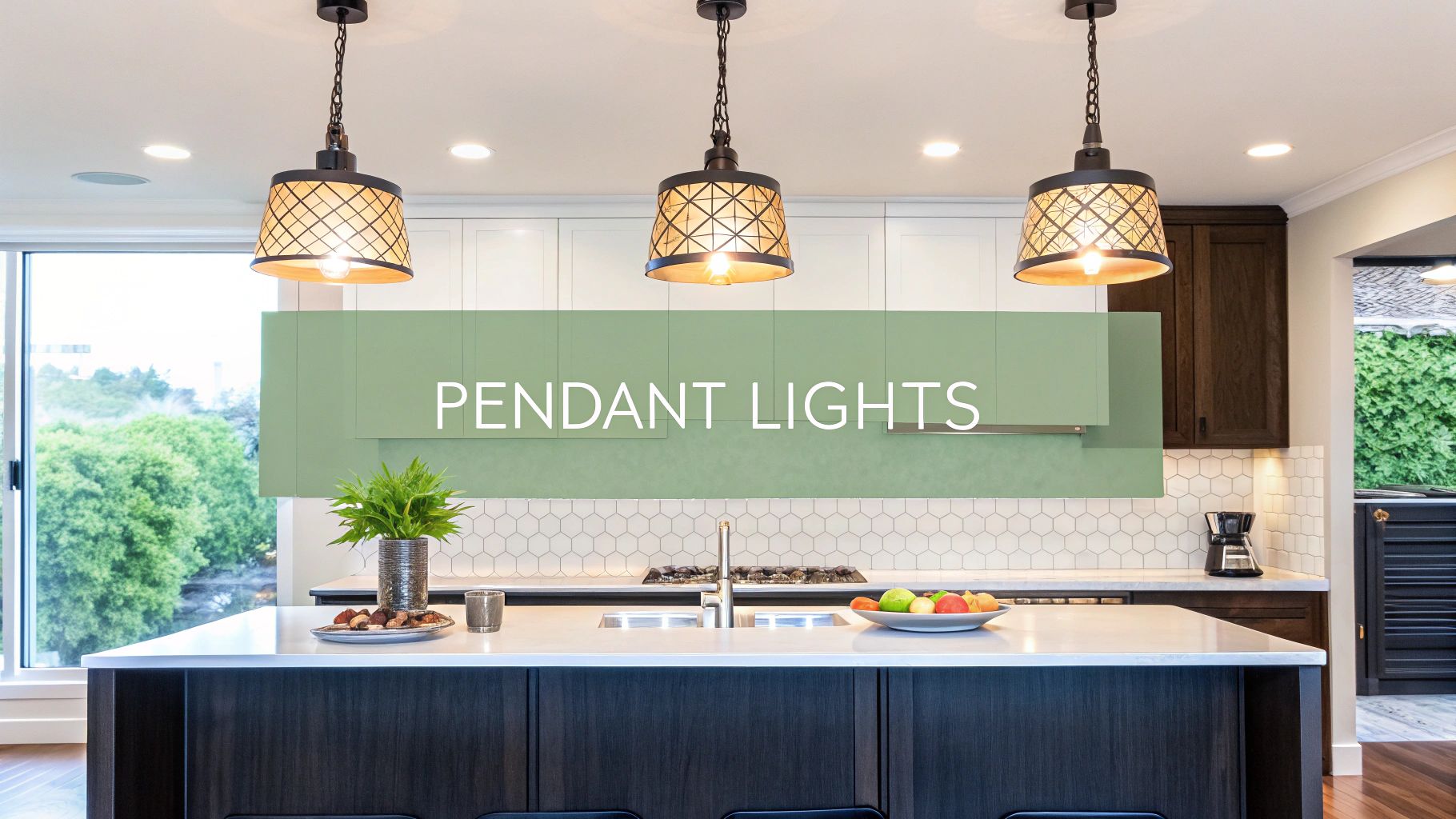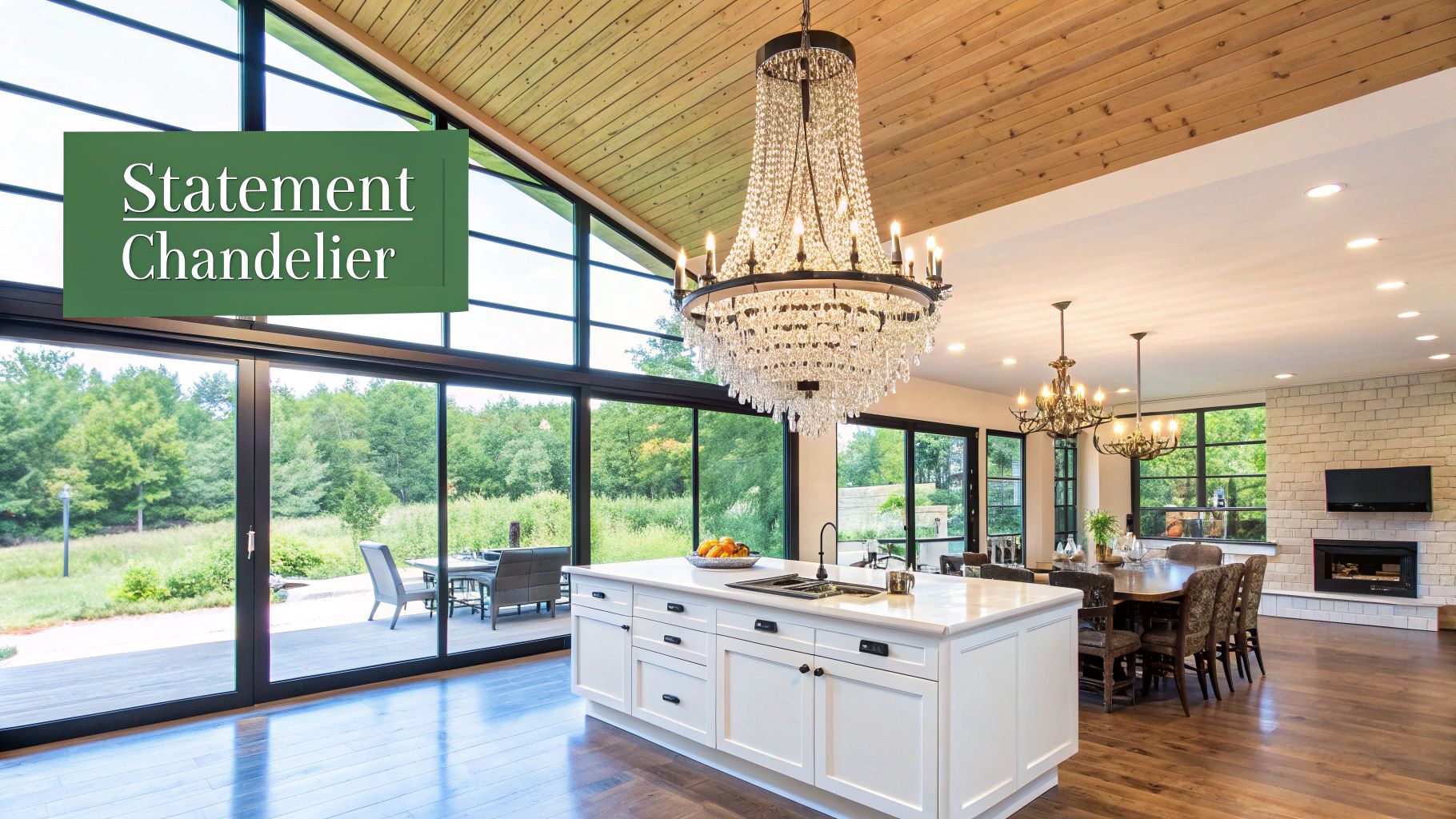
10 Kitchen lighting ideas You Should Know
Getting Started
Transform your kitchen from drab to fab with strategic lighting. This comprehensive listicle explores ten brilliant kitchen lighting ideas, covering everything from ambient glow to focused task lighting. Whether you're renovating, redecorating, or simply seeking a quick refresh, these ideas will illuminate your culinary space. We'll dive into practical and stylish solutions, providing specific product suggestions and styling tips along the way. Discover how the right kitchen lighting can enhance your cooking experience, improve functionality, and create a welcoming atmosphere.
This guide goes beyond basic overhead fixtures. We'll explore innovative techniques, such as toe-kick lighting and cabinet interior illumination, to add depth and dimension. Learn how to effectively layer lighting to achieve a balanced and visually appealing result. You'll discover the power of pendant lights over kitchen islands, the versatility of track lighting systems, and the elegance of statement chandeliers. We’ll even cover smart lighting systems and ways to maximise natural light, all crucial for creating a truly inviting kitchen. Explore these ten kitchen lighting ideas to create a space you'll love.
1. Layered Lighting Design
Layered lighting design is a crucial element for creating a functional and inviting kitchen. This approach combines three types of lighting: ambient, task, and accent, to ensure every area is properly illuminated for various activities while also enhancing the overall aesthetic. Unlike a single overhead fixture, layering light creates depth, highlights key features, and allows for customised illumination depending on the task at hand. For NZ homeowners looking to maximise their kitchen space, layered lighting can truly transform the room's functionality and atmosphere. Thinking about your kitchen layout? Learn more about top kitchen layouts in 2025.
How Layered Lighting Works
The core principle is to build up light in layers, starting with a base of ambient lighting, which provides overall illumination. Next, task lighting is incorporated in specific areas where focused light is required, like above countertops and the cooktop. Finally, accent lighting is used to highlight architectural features or decorative elements, adding a touch of drama and style.
Examples of Layered Lighting
High-end kitchen showrooms from brands like Poggenpohl and SieMatic often showcase the power of layered lighting. Celebrity chef kitchens featured in Architectural Digest also exemplify this approach, demonstrating how it can elevate both form and function. Award-winning kitchen designs by the NKBA (National Kitchen & Bath Association) further validate the impact of layered lighting design in achieving a balanced and beautiful kitchen environment.
Implementing Layered Lighting in Your Kitchen
-
Start with ambient lighting: Recessed lighting, pendant lights, or a central chandelier can serve as your base layer.
-
Add task lighting: Under-cabinet lighting, pendants over islands, and adjustable spotlights above work areas provide focused light for specific tasks.
-
Incorporate accent lighting: Interior cabinet lighting, toe-kick lighting, or strategically placed spotlights can highlight decorative elements and create visual interest.
-
Control with dimmers: Installing dimmer switches allows you to adjust the brightness levels of each layer, creating different moods and adapting to various needs throughout the day.
The following infographic visualises the core concepts of layered lighting design, showing the relationship between ambient, task, and accent lighting.

The infographic illustrates how each layer contributes to a well-lit and visually appealing kitchen. The interconnectedness of these elements emphasises that layered lighting is not just about functionality, but also about creating depth and balance. By strategically combining these three types of lighting, you can transform your kitchen into a stylish and practical space.
2. Under-Cabinet LED Strip Lighting
Under-cabinet LED strip lighting is a transformative kitchen lighting idea, providing focused task lighting precisely where you need it most: on your countertops. These low-profile strips tuck neatly beneath upper cabinets, eliminating shadows cast by overhead fixtures and enhancing both functionality and aesthetics. For NZ homeowners seeking a modern and practical lighting solution, LED strips offer a sleek and energy-efficient way to brighten workspaces while adding a touch of contemporary style.

How Under-Cabinet Lighting Works
LED strip lights are flexible circuits populated with small, bright LEDs. They can be easily adhered to the underside of cabinets, providing a continuous and even light source. Their compact size makes them unobtrusive, and their energy efficiency makes them a cost-effective choice for kitchen lighting ideas.
Examples of Under-Cabinet Lighting
IKEA's OMLOPP and MITTLED series offer affordable and accessible options for under-cabinet lighting. High-end installations featuring Philips Hue lightstrips showcase the potential for smart integration and customisable lighting schemes. Luxury home renovations featured on HGTV often incorporate custom LED strip installations, demonstrating their versatility in various kitchen designs.
Implementing Under-Cabinet Lighting in Your Kitchen
-
Choose the right colour temperature: Warm white (2700K-3000K) creates a cozy ambiance, while cool white (4000K) is ideal for task-oriented lighting.
-
Optimise placement: Install strips closer to the front edge of cabinets to minimise shadows on the countertop.
-
Ensure a clean finish: Use aluminium channels to conceal the strips and create a professional look.
-
Consider smart lighting: Smart LED strips offer dimming, colour-changing capabilities, and integration with other smart home devices.
This video demonstrates the impact of properly installed under-cabinet lighting, highlighting the benefits of this kitchen lighting idea for both functionality and style. By following these tips, you can elevate your kitchen's lighting design and create a more welcoming and practical workspace.
3. Pendant Lights Over Kitchen Islands
Pendant lights suspended above kitchen islands or peninsulas offer focused task lighting while also serving as a striking decorative focal point. These fixtures effectively bridge the gap between functionality and style in kitchen design, making them a popular choice for NZ homeowners. Pendant lights not only illuminate key work areas but also add personality and visual interest to the heart of the home.

How Pendant Lighting Works
Pendant lights work by directing light downwards, providing focused illumination over the island countertop. This makes them ideal for tasks like food preparation, chopping, and serving. The variety of styles available, from sleek and modern to rustic and vintage, allows homeowners to customise their kitchen's aesthetic.
Examples of Pendant Lighting
Designers like Joanna Gaines and Sarah Richardson frequently incorporate pendant lights into their kitchen designs, demonstrating their versatility. High-end kitchen showrooms often feature designer pendants from brands like Visual Comfort, Arteriors, and Rejuvenation, showcasing their impact on the overall kitchen aesthetic. Tom Dixon's Beat pendants are a popular choice in modern kitchens, while Restoration Hardware's vintage-inspired options suit farmhouse styles.
Implementing Pendant Lighting in Your Kitchen
-
Height: Hang pendants 30-36 inches above the island surface for optimal task lighting and to avoid head bumps.
-
Spacing: When using multiple pendants, space them 24-30 inches apart for even illumination.
-
Size: Choose pendant widths proportional to the island size to maintain visual balance.
-
Dimmers: Installing dimmer switches allows you to adjust the brightness and create different moods.
By carefully considering these factors, NZ homeowners can effectively utilise pendant lights to enhance both the functionality and style of their kitchen islands. The focused task lighting combined with decorative appeal makes pendant lights a valuable addition to any kitchen lighting plan.
4. Recessed Ceiling Lights (Can Lights)
Recessed ceiling lights, often called can lights, offer a sleek and modern approach to kitchen lighting. These flush-mounted fixtures are installed directly into the ceiling cavity, providing a clean, unobtrusive look. They offer versatile illumination, serving as both ambient and task lighting, depending on placement and trim style. Modern recessed lights predominantly use energy-efficient LED technology, ensuring long-lasting performance while maintaining a minimalist aesthetic. This makes them a popular choice for contemporary kitchen designs.
How Recessed Lighting Works
Recessed lights consist of a housing installed within the ceiling and a trim that frames the light source. The trim can be directional, allowing you to focus light on specific areas, or diffuse, providing a softer, more general illumination. Different trim styles, such as baffle, reflector, and parabolic, offer varying levels of light control and glare reduction. The choice of trim greatly influences the overall effect of the recessed lighting.
Examples of Recessed Lighting
High-end kitchen renovations often feature strategically placed recessed lights to highlight architectural details and create a sense of spaciousness. Brands like Halo and Juno are frequently used in residential applications for their quality and versatility. You might find inspiration for your own lighting upgrades from exploring the design of kitchen appliances in the best rangehoods in NZ, as they can often complements well-planned lighting schemes. For more complex and customisable lighting solutions, Lutron and Cooper Lighting offer sophisticated systems suitable for high-end projects.
Implementing Recessed Lighting in Your Kitchen
-
Spacing is key: Space recessed lights approximately 4-6 feet apart for even ambient lighting coverage. Adjust spacing as needed depending on ceiling height and desired light levels.
-
Directional lighting: Use adjustable trims to direct light towards specific work areas, such as countertops and islands, creating effective task lighting.
-
Layered approach: Combine recessed lights with other lighting types, like under-cabinet lighting and pendants, to achieve a layered lighting design and enhance the overall aesthetic.
-
Insulation considerations: Ensure you use IC-rated (insulation contact) fixtures for ceilings with insulation to prevent overheating and fire hazards. This is crucial for safety and compliance.
5. Statement Chandeliers
Statement chandeliers are dramatic, eye-catching ceiling fixtures that serve as both functional lighting and artistic centrepieces. They elevate kitchen design beyond mere illumination, introducing a touch of elegance and personality. Modern kitchen chandeliers combine traditional elegance with contemporary functionality, often featuring LED technology and innovative materials. These striking fixtures can transform a kitchen into a sophisticated and stylish space.

How Statement Chandeliers Work
A statement chandelier serves as a focal point, drawing the eye upwards and adding a sense of grandeur. It provides ambient lighting, illuminating the entire kitchen space. However, unlike a standard overhead fixture, a statement chandelier adds a layer of artistic expression. It contributes significantly to the overall aesthetic of the room.
Examples of Statement Chandeliers
Luxury lighting brands like Schonbek offer exquisite crystal chandeliers that elevate kitchen designs. Kichler's modern farmhouse chandeliers work beautifully in transitional kitchens, adding a touch of rustic charm. For contemporary kitchens, Arteriors' designs offer sleek and sophisticated options, often seen in high-end residential projects.
Implementing a Statement Chandelier in Your Kitchen
-
Proportionality: Ensure the chandelier is proportional to the room size. A large chandelier in a small kitchen can feel overwhelming.
-
Dimmer Switches: Install dimmer switches to control the brightness and create different moods. This adds versatility to the lighting scheme.
-
Ceiling Height: Consider the ceiling height and traffic patterns. A low-hanging chandelier can obstruct movement.
-
Design Harmony: Choose a chandelier style that complements your overall kitchen design, whether it's modern, traditional, or transitional.
Statement chandeliers are an excellent choice for NZ homeowners looking to create a focal point and add a touch of luxury to their kitchens. They provide both practical illumination and an artistic statement, enhancing the overall ambience and style of the space. By carefully considering size, style, and placement, you can integrate a statement chandelier seamlessly into your kitchen design.
6. Track and Rail Lighting Systems
Track and rail lighting systems offer a flexible and customisable approach to kitchen lighting. These systems utilise adjustable fixtures mounted on tracks or rails, allowing you to direct light precisely where it's needed. This adaptability makes them ideal for evolving kitchen layouts and changing lighting needs, offering a practical solution for both task and accent lighting. For NZ homeowners seeking adaptable lighting solutions, track and rail systems provide excellent control over illumination. Want to revamp your kitchen lighting as part of a larger renovation? Learn more about top kitchen renovation ideas on a budget for 2025.
How Track and Rail Lighting Works
The system consists of a track or rail, typically installed on the ceiling, and multiple light fixtures attached to it. These fixtures can be spotlights, pendants, or even decorative elements, offering design versatility. The adjustability of the fixtures allows you to direct light towards specific areas, such as countertops, islands, or artwork, ensuring optimal illumination for various tasks and highlighting key features.
Examples of Track and Rail Lighting
Juno track lighting systems are a popular choice in contemporary kitchens, while WAC Lighting's H-track systems are often seen in modern designs. For high-end installations, Tech Lighting's MonoRail systems exemplify the sleek and sophisticated look achievable with track lighting. These brands showcase the diverse applications and aesthetic possibilities of track and rail systems.
Implementing Track and Rail Lighting in Your Kitchen
-
Position tracks strategically: Avoid placing tracks directly above work surfaces to minimise shadows. Consider the layout of your kitchen and the primary areas requiring illumination.
-
Vary fixture types: Combine different fixture styles on the same track to achieve layered lighting effects. Use spotlights for task lighting and pendants for ambient or accent lighting.
-
Consider low-voltage options: Low-voltage track lighting can offer energy efficiency without compromising brightness. This is a sustainable choice for environmentally conscious homeowners.
-
Choose complementary finishes: Select track finishes that coordinate with your kitchen hardware and overall design aesthetic. This creates a cohesive and polished look.
7. Cabinet Interior Lighting
Cabinet interior lighting transforms dark, hard-to-navigate storage spaces into well-lit, easily accessible areas. Specialised lighting installed inside cabinets, drawers, and pantries dramatically improves visibility and elevates the entire kitchen experience. This often-overlooked element enhances functionality and adds a touch of luxury. For NZ homeowners seeking both practicality and style, cabinet lighting offers a compelling upgrade.
How Cabinet Interior Lighting Works
The principle is simple: illuminate the interior of cabinets and drawers to make contents clearly visible. Various lighting systems are available, from simple battery-powered puck lights to sophisticated integrated LED systems. These systems can be activated manually, with door-activated switches, or with motion sensors for automatic illumination. Careful planning during the kitchen design phase ensures optimal placement and wiring for a seamless integration.
Examples of Cabinet Interior Lighting
European cabinet manufacturers like Blum and Hafele offer sophisticated Loox LED systems that seamlessly integrate into their cabinetry. Luxury kitchen designers and high-end builders regularly incorporate interior cabinet lighting in their projects, showcasing its ability to create a premium feel. Richelieu also offers a diverse range of cabinet lighting solutions suitable for various budgets and styles.
Implementing Cabinet Interior Lighting in Your Kitchen
-
Plan ahead: Integrate lighting considerations into your kitchen design process to ensure proper wiring and placement.
-
Choose the right system: Battery-powered lights offer flexibility, while wired LED systems provide a more integrated and consistent look.
-
Opt for warm white LEDs: Warm white light enhances color rendering, making it easier to identify items within the cabinet.
-
Consider motion sensors: Automatic activation adds convenience and reduces energy consumption.
-
Explore rechargeable options: Rechargeable battery systems offer a balance between convenience and sustainability.
By incorporating cabinet interior lighting, you can transform your kitchen storage from a source of frustration to a streamlined and stylish element. The improved visibility and accessibility enhance functionality, while the subtle glow adds a touch of elegance and elevates the overall aesthetic of your kitchen.
8. Toe-Kick Lighting
Toe-kick lighting is a subtle yet effective kitchen lighting idea that adds both practicality and ambiance. This involves installing low-profile LED strip lights in the recessed area at the base of your cabinets, creating a soft glow that illuminates the floor. This not only enhances safety by preventing nighttime stumbles but also adds a touch of elegance by making cabinets and islands appear to float. For NZ homeowners looking to modernise their kitchens, toe-kick lighting offers an innovative way to elevate both form and function.
How Toe-Kick Lighting Works
LED strips are discreetly placed within the toe-kick, shining downwards onto the floor. These lights can be powered by standard wiring or, for greater control, integrated into a smart home system. The subtle illumination they provide enhances visibility without being overpowering, making them ideal for navigating the kitchen at night.
Examples of Toe-Kick Lighting
Smart home kitchens often incorporate Philips Hue lightstrips in the toe-kick for customisable colours and automated control. Luxury home projects showcase bespoke LED installations that seamlessly integrate with the overall kitchen design. Contemporary kitchen designs frequently feature toe-kick lighting as a key element, demonstrating its versatility and visual appeal.
Implementing Toe-Kick Lighting in Your Kitchen
-
Choose warm white LEDs: This creates a cozy and inviting atmosphere, perfect for everyday use.
-
Consider smart controls: Dimmer switches or smart home integration allow you to adjust brightness and even change colours for special occasions.
-
Ensure proper sealing: Protect the LED strips from moisture damage by ensuring a watertight seal during installation.
-
Consult a professional: For complex installations or integration with smart home systems, professional assistance is recommended.
Toe-kick lighting adds a touch of sophistication and functionality to any kitchen. Its subtle illumination enhances safety and aesthetics, making it a valuable addition to modern kitchen lighting design. By strategically incorporating this understated lighting element, you can create a more welcoming and practical kitchen space.
9. Natural Light Enhancement
Natural light enhancement is a key element in creating a bright and welcoming kitchen. This approach focuses on maximising and optimising daylight through strategic design choices, reducing reliance on artificial lighting during the day and enhancing the overall kitchen atmosphere. For NZ homeowners, utilising natural light can significantly impact the feel and functionality of their kitchens, promoting a connection with the outdoors. Considering a smaller kitchen remodel? Learn more about small kitchen ideas.
How Natural Light Enhancement Works
The core principle is to capture and distribute natural light effectively. This involves thoughtful placement of windows and skylights, along with the use of light-reflective surfaces to amplify the available daylight. Unlike relying solely on artificial lighting, natural light creates a dynamic and inviting space that changes throughout the day.
Examples of Natural Light Enhancement
Contemporary kitchen designs often showcase large picture windows that flood the space with light. Renovations frequently incorporate Velux skylights to bring natural light into kitchens without direct roof access. Even kitchens with limited wall space can benefit from solar tubes, which channel daylight from the roof into the interior.
Implementing Natural Light Enhancement in Your Kitchen
-
Window Placement: Position windows strategically to avoid direct glare on work surfaces while maximising light intake.
-
Reflective Surfaces: Use light-coloured backsplashes, countertops, and cabinetry to reflect and distribute natural light.
-
Window Treatments: Consider blinds or shades to control the amount of light entering the kitchen and manage glare.
-
Supplementary Lighting: Incorporate artificial lighting to ensure consistent illumination during evenings and overcast days.
Natural light not only reduces energy consumption but also enhances the overall aesthetic and well-being of those using the kitchen. By strategically incorporating these design elements, you can create a brighter, more inviting, and energy-efficient kitchen.
10. Smart Lighting Systems
Smart lighting systems are transforming kitchen lighting ideas by offering unprecedented control and integration. These connected solutions allow you to adjust brightness, color temperature, and even create custom lighting schedules, all managed remotely via smartphone apps, voice commands, or automated systems. Unlike traditional lighting, smart systems can adapt to your needs and preferences, enhancing both functionality and ambiance. For NZ homeowners seeking modern and adaptable kitchen lighting, smart systems are a game-changer. Want to upgrade your appliances as well? Learn more about tips for buying appliances.
How Smart Lighting Works
Smart lighting systems utilise wireless communication protocols, like Wi-Fi or Bluetooth, to connect individual lights or entire circuits to a central hub or directly to your smartphone. This connectivity allows you to control your lights remotely, automate their operation based on time of day or occupancy, and even integrate them with other smart home technologies, such as security systems or voice assistants.
Examples of Smart Lighting
The Philips Hue ecosystem is a popular choice for smart home kitchens, offering a wide range of bulbs and fixtures with extensive customisation options. Lutron Caseta provides smart switches and dimmers that can upgrade existing fixtures to smart functionality. For tech-forward homes, LIFX and Nanoleaf offer dynamic lighting systems with vibrant colour options and creative effects.
Implementing Smart Lighting in Your Kitchen
-
Start with smart switches: Replace traditional switches with smart versions to control existing fixtures remotely.
-
Choose compatible systems: Select a system that integrates with your preferred voice assistant, such as Google Assistant or Alexa.
-
Create lighting scenes: Set up different lighting scenes for various kitchen activities, like cooking, dining, or entertaining.
-
Consider smart sensors: Integrate motion sensors or occupancy sensors for automatic lighting control.
To further enhance your kitchen with natural elements, explore these green home decor ideas. Smart lighting enhances not only convenience but also energy efficiency. By scheduling lights and utilising sensors, you can reduce energy consumption and contribute to a more sustainable home.
Top 10 Kitchen Lighting Ideas Comparison
Lighting Type
Implementation Complexity 🔄
Resource Requirements ⚡
Expected Outcomes 📊
Ideal Use Cases 💡
Key Advantages ⭐
Layered Lighting Design
High – requires planning & multiple circuits
High – multiple fixtures & controls
Balanced, functional, atmospheric lighting
Whole kitchen with varied tasks and moods
Flexible, eliminates shadows, enhances mood
Under-Cabinet LED Strip
Low to Medium – easy to install but wiring visible
Low – LED strips, power supply
Shadow-free, focused task lighting
Countertop tasks, workspace illumination
Energy efficient, cost-effective, easy install
Pendant Lights Over Islands
Medium – needs precise hanging & wiring
Medium – fixtures, wiring, switches
Focused task light and decorative focal point
Kitchen islands, dining areas
Stylish focal point, task lighting, customizable
Recessed Ceiling Lights
Medium – requires ceiling cavity & wiring
Medium – multiple fixtures
Even ambient and task lighting
General kitchen lighting, minimalist spaces
Clean look, widespread illumination
Statement Chandeliers
High – heavy fixtures, professional install
High – large fixture, structural needs
Dramatic visual impact and ambient light
Kitchens with high ceilings, entertaining zones
Elegant, eye-catching, adds value
Track and Rail Lighting
Medium – track mounting and positioning
Medium – track systems and fixtures
Flexible, adjustable directional lighting
Variable layouts, highlighting specific areas
Highly customizable, expandable
Cabinet Interior Lighting
Medium to High – custom installs inside cabinetry
Medium – LED pods/strips, sensors
Improved storage visibility and luxury feel
Inside cabinets, pantries, drawers
Enhances usability, luxury appeal
Toe-Kick Lighting
Low – simple strip installation
Low – low-profile LED strips
Soft ambient floor-level lighting
Night navigation, ambiance around cabinets/island
Safety, subtle accent, inexpensive
Natural Light Enhancement
High – architectural modifications
High – windows, skylights, reflective surfaces
Bright, energy-saving daytime lighting
New builds or renovations focused on sustainability
Low energy use, mood improvement
Smart Lighting Systems
Medium to High – setup and integration required
Medium to High – smart bulbs, hubs
Customisable, automated lighting control
Tech-savvy kitchens, integration with smart homes
Convenience, energy efficiency, scene customization
Final Thoughts
From layered lighting designs that create depth and ambience to the targeted illumination of under-cabinet LED strips and the dramatic flair of statement chandeliers, the options for kitchen lighting are vast and exciting. We've explored ten key kitchen lighting ideas, each offering a unique way to transform your space, improve functionality, and reflect your personal style. Remember, effective kitchen lighting isn't just about aesthetics; it's about creating a space that's both beautiful and practical.
Key Takeaways and Actionable Steps
-
Prioritise Layering: Combining ambient, task, and accent lighting is crucial. Think recessed lights for overall illumination, pendants over your island for focused task lighting, and cabinet lighting to showcase your beautiful dinnerware.
-
Consider the Size and Shape of Your Kitchen: A small kitchen might benefit from light, airy fixtures, while a larger space can accommodate bolder statement pieces.
-
Don't Underestimate Natural Light: Maximise natural light by using sheer window treatments or strategically placed mirrors. This not only enhances the brightness of your kitchen but also contributes to energy efficiency.
-
Embrace Smart Technology: For homeowners interested in automating their lighting and maximising energy savings, integrating a smart lighting system with an energy management system can be a game-changer. This allows you to control your lights remotely, schedule them to turn on and off automatically, and even adjust the brightness and colour temperature based on your preferences. The source for this information is the Energie Management Systeem: Complete Gids voor Installatie & Besparing from Stroom Loods.
The Impact of Effective Kitchen Lighting
The right kitchen lighting can completely transform the heart of your home. It enhances the beauty of your design choices, improves visibility for cooking and food preparation, and creates a welcoming atmosphere for family and friends. By carefully considering the various lighting options available and implementing these ideas, you can create a kitchen that is not only functional but also a stylish and inviting space you'll love spending time in.
From brightening up your countertops for meal prep to setting the perfect mood for a dinner party, well-planned kitchen lighting is an investment that pays off in both practicality and aesthetics. Whether you're renovating your entire kitchen or simply looking to update your current lighting fixtures, taking the time to explore these ideas and find the perfect solutions for your space will undoubtedly enhance your cooking experience and the overall enjoyment of your kitchen.
Looking for inspiration and organisation solutions as you embark on your kitchen lighting project? Folders offers a range of lighting solutions along a large range of kitchen appliances that will match any kitchen decor lighting solution you choose to make your home feel great.
-
